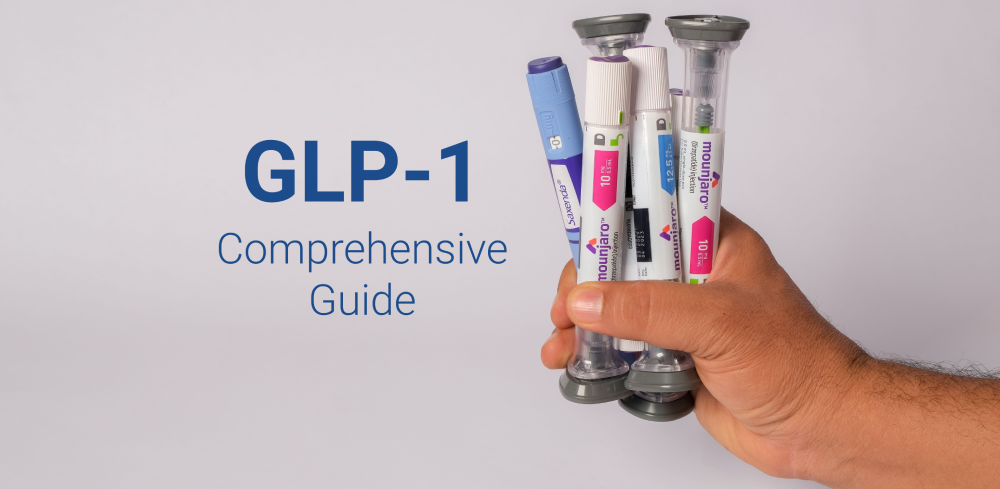
Tirzepatide: A Novel Weight Loss Medication
Updated May 31, 2024


Eli Luft, PA-C
Dr. Paul Rivas
Key Takeaways
- 1.Tirzepatide is a dual GIP and GLP-1 receptor agonist approved for chronic weight management in adults with obesity or overweight.
- 2.Clinical trials demonstrated remarkable weight loss with tirzepatide, up to 20.9% of body weight over 72 weeks.
- 3. Common side effects include gastrointestinal issues like nausea, diarrhea, and vomiting, which are generally mild to moderate.
- 4. Tirzepatide is administered via weekly subcutaneous injection, with gradual dose escalation to improve tolerability.
- 5.Ongoing research is exploring the potential of tirzepatide for other indications, such as heart failure, sleep apnea, and non-alcoholic fatty liver disease.
Introduction
Tirzepatide, the active ingredient in Zepbound, is a novel dual glucose-dependent insulinotropic polypeptide (GIP) and glucagon-like peptide-1 (GLP-1) receptor agonist. [1] This means that it activates receptors for two naturally occurring hormones, GIP and GLP-1, which play a crucial role in regulating appetite and food intake. By mimicking the actions of these hormones, tirzepatide helps reduce appetite and calorie consumption, leading to weight loss.
mechanism of action of tirzepatide is unique and differs from other weight loss medications currently available. [2] Unlike traditional appetite suppressants or medications that primarily target the central nervous system, tirzepatide works peripherally by interacting with GIP and GLP-1 receptors found in the gut and other areas of the body involved in appetite regulation. This dual agonist approach is thought to provide a more comprehensive and effective way to promote weight loss while also potentially offering additional metabolic benefits.
Approved Uses
Zepbound (tirzepatide) is approved by the FDA for chronic weight management in adults with obesity (body mass index of 30 kg/m2 or greater) or overweight (body mass index of 27 kg/m2 or greater) with at least one weight-related condition, such as high blood pressure, type 2 diabetes, or high cholesterol. [1] It is intended to be used in conjunction with a reduced-calorie diet and increased physical activity.
Clinical Trials and Efficacy
SURMOUNT Trials for Obesity and Overweight
The SURMOUNT clinical trial program was designed to evaluate the efficacy and safety of tirzepatide for chronic weight management in adults with obesity or overweight. The program consists of six registration studies, four of which are global trials, enrolling more than 5,000 participants across various populations. [3]
One of the pivotal trials, SURMOUNT-1, investigated the effects of tirzepatide in adults without diabetes. The results, published in the New England Journal of Medicine, demonstrated remarkable weight loss with tirzepatide. At the highest approved dose of 15 mg once weekly, participants lost an average of 20.9% of their body weight over 72 weeks, compared to 3.1% for the placebo group. [1] The average starting weight was 231 pounds, and the average body mass index (BMI) was 38 kg/m2, indicating obesity. This weight loss equates to a reduction of approximately 48.3 pounds, bringing the average weight down to about 182.7 pounds.
Another key trial, SURMOUNT-2, focused on adults with obesity or overweight and type 2 diabetes. The results were equally impressive, with participants taking tirzepatide 15 mg losing an average of 15.7% of their body weight over 72 weeks, compared to 3.3% for the placebo group. [3] The weight loss was accompanied by improvements in glycemic control and other cardiometabolic parameters, underscoring the potential benefits of tirzepatide in managing both obesity and type 2 diabetes.
SURPASS Trials for Type 2 Diabetes
While the SURMOUNT trials focused on weight management, the SURPASS trials evaluated tirzepatide’s efficacy in improving glycemic control in adults with type 2 diabetes. These trials demonstrated that tirzepatide not only improved blood sugar levels but also led to significant weight loss, a desirable outcome for many individuals with type 2 diabetes who are overweight or obese.
Weight Loss and Metabolic Benefits
The impressive weight loss achieved with tirzepatide in the SURMOUNT trials was accompanied by improvements in various metabolic parameters. Participants experienced reductions in blood pressure, lipid levels, and fasting insulin, suggesting potential benefits for cardiovascular and metabolic health. [4] Additionally, self-reported physical function and quality of life measures improved, highlighting the potential positive impact of weight loss on overall well-being.
The safety profile of tirzepatide in the SURMOUNT trials was consistent with previous studies and the GLP-1 receptor agonist class. The most common side effects were gastrointestinal-related, such as nausea, diarrhea, and vomiting, which were generally mild to moderate and transient. [3]
Safety and Side Effects
Common Side Effects
Tirzepatide, like other medications in its class, can cause a range of side effects, with gastrointestinal issues being the most common. According to the FDA, nausea, diarrhea, vomiting, constipation, abdominal discomfort, and indigestion are among the frequently reported adverse events associated with Zepbound (tirzepatide).[1] These side effects are generally mild to moderate in severity and tend to occur during the initial dose-escalation phase, often subsiding over time as the body adjusts to the medication.
Warnings and Precautions
While tirzepatide has shown impressive efficacy, it is important to be aware of certain considerations. Healthcare providers should carefully evaluate the warnings and precautions associated with its use. One area of attention is the potential risk of thyroid tumors, including thyroid cancer. [1] Patients should report any symptoms such as lumps or swelling in the neck, hoarseness, difficulty swallowing, or shortness of breath to their healthcare provider. Tirzepatide is not recommended for individuals with a personal or family history of medullary thyroid carcinoma (MTC) or Multiple Endocrine Neoplasia syndrome type 2 (MEN 2).
Other potential side effects that require careful monitoring include pancreatitis, gallbladder problems, hypoglycemia (particularly when used in combination with insulin or sulfonylureas), acute kidney injury, and diabetic retinopathy in patients with type 2 diabetes. [1] Patients should also be advised to report any symptoms of severe allergic reactions, such as swelling of the face, lips, tongue, or throat, breathing difficulties, or rapid heartbeat.
Long-term Safety Considerations
While clinical trials for tirzepatide have provided valuable insights into its safety profile, we still need more long-term data on potential risks. Ongoing monitoring and follow-up are crucial to identifying any rare or delayed side effects that might occur over time.
One area of interest is its impact on heart health, given the weight loss and improvements in related health markers seen in trials. Although these early results are promising, larger and longer-term studies are needed to fully understand the heart-related safety and benefits of tirzepatide in different groups of people.
Additionally, since tirzepatide may be used as a long-term treatment for obesity and weight management, its effects on other organs, such as the liver, kidneys, and hormone systems, need to be closely watched. Continued research and careful monitoring will be essential in identifying any potential safety concerns and guiding the appropriate use of this medication in everyday practice.
Administration and Dosing
Dosage and Titration
Zepbound (tirzepatide) is administered by subcutaneous injection once weekly. The recommended starting dose is 2.5 mg, gradually increased to improve tolerability and minimize gastrointestinal side effects. While the clinical trial indicates that 5 mg, 10 mg, and 15 mg are the maintenance doses, clinically, we see that patients can reach and maintain at any dose. The dosing schedule is as follows:
- Week 1-4: 2.5 mg
- Week 5-8: 5 mg
- Week 9-12: 7.5 mg
- Week 13-16: 10 mg
- Week 17-20: 12.5 mg
- Week 21 onward: 15 mg
Patients experiencing intolerable side effects during this phase can have their dose temporarily reduced or maintained at the current level until the side effects subside, before attempting to increase the dose again.
Injection Instructions
Zepbound is supplied as a once-weekly, single-dose prefilled pen or syringe for subcutaneous injection. The injection should be administered into the abdomen, thigh, or upper arm, with the injection site rotated each week to minimize the risk of injection site reactions.[1]
Patients should be instructed on proper injection technique, including selecting and preparing the injection site, handling the prefilled pen or syringe, and safely disposing of used needles and injection materials. Healthcare providers should demonstrate the injection procedure to patients and caregivers before initiating treatment with Zepbound.
Combination with Other Medications
Zepbound should not be used in combination with any other glucagon-like peptide-1 (GLP-1) receptor agonist medications. [1]
Patients taking insulin or sulfonylureas (medications that stimulate insulin secretion) should be closely monitored for hypoglycemia (low blood sugar) when initiating or adjusting the dose of Zepbound, as the medication may increase the risk of hypoglycemic events. [1] Dose adjustments of these concomitant medications may be necessary to minimize the risk of hypoglycemia.
Future Prospects and Ongoing Research
Potential for Other Indications
The impressive weight loss achieved with tirzepatide in clinical trials has sparked interest in exploring its potential for other indications beyond obesity and overweight. Researchers are actively investigating the use of tirzepatide in conditions closely linked to excess weight, such as heart failure with preserved ejection fraction (HFpEF), obstructive sleep apnea (OSA), and non-alcoholic fatty liver disease. [3]
Heart failure with preserved ejection fraction is a form of heart failure characterized by stiffening of the heart muscles, making it difficult for the heart to fill and pump blood effectively. Obesity is a significant risk factor for HFpEF, and weight loss has been shown to improve symptoms and outcomes in these patients. [4] By promoting substantial weight reduction, tirzepatide could potentially alleviate the burden on the heart and improve overall cardiovascular health in individuals with HFpEF.
Obstructive sleep apnea is a condition characterized by repeated episodes of partial or complete obstruction of the upper airway during sleep, leading to disrupted breathing and poor sleep quality. Obesity is a major risk factor for OSA, and weight loss is often recommended as a first-line treatment. [1] The significant weight loss induced by tirzepatide could potentially reduce the severity of OSA or even resolve the condition in some individuals, improving their sleep quality and overall health.
Comparative Studies with Other Medications
As tirzepatide continues to gain traction in treating obesity and overweight, comparative studies with other approved medications in this class are crucial. These studies help clinicians and patients make informed decisions about the most appropriate treatment options based on efficacy, safety, tolerability, and individual patient characteristics.
Comparing tirzepatide to other incretin-based therapies, such as semaglutide (Wegovy) and liraglutide (Saxenda), is of particular interest. Recent studies show that tirzepatide achieves greater weight loss than both semaglutide and liraglutide. For instance, tirzepatide has been shown to result in an average weight loss of 20.9% over 72 weeks, compared to semaglutide’s 14.9% and liraglutide’s 8.4% over similar periods. Additionally, while both tirzepatide and semaglutide share similar gastrointestinal side effects, tirzepatide may have a slightly higher incidence of these issues. However, clinically at Rivas Medical Weight Loss, we have observed fewer overall side effects with tirzepatide.
Furthermore, comparative studies with non-incretin-based weight loss medications, such as phentermine-topiramate (Qsymia) and naltrexone-bupropion (Contrave), are valuable. These studies provide insights into the relative advantages and disadvantages of different pharmacological approaches to weight management, helping to identify specific patient populations that may respond better to certain medications or combinations of therapies.
Long-term Efficacy and Weight Maintenance
While the initial weight loss achieved with tirzepatide in clinical trials has been impressive, the long-term efficacy and ability to maintain weight loss over extended periods remain crucial areas of investigation. The SURMOUNT-4 trial, which evaluated the effects of discontinuing tirzepatide after an initial period of weight loss, provided valuable insights into this aspect .
The findings from SURMOUNT-4 demonstrated that participants who discontinued tirzepatide after achieving significant weight loss regained a substantial portion of the lost weight within a year . This highlights the importance of long-term adherence to tirzepatide treatment for maintaining weight loss and underscores the chronic nature of obesity as a condition requiring ongoing management.
Further research is needed to determine the optimal duration of tirzepatide treatment and the potential for intermittent or cyclical use to maintain weight loss while minimizing potential side effects or adverse events associated with long-term use. Additionally, studies exploring the combination of tirzepatide with intensive lifestyle interventions, such as dietary modifications and exercise programs, could provide insights into maximizing weight loss and long-term maintenance strategies.
Conclusion
Tirzepatide represents a significant advancement in the pharmacological management of obesity and overweight. Its unique dual agonist mechanism of action, targeting both GIP and GLP-1 receptors, has demonstrated remarkable efficacy in promoting substantial and sustained weight loss in clinical trials. The impressive results, coupled with improvements in various metabolic parameters, underscore the potential of tirzepatide to address the multifaceted challenges associated with obesity and related comorbidities.
While the initial safety profile of tirzepatide appears favorable, ongoing vigilance and real-world monitoring will be crucial in identifying any rare or long-term adverse effects. Additionally, further research is needed to explore the potential of tirzepatide in other weight-related conditions, comparative studies with existing weight loss medications, and strategies for long-term weight maintenance.
As the obesity epidemic continues to pose significant challenges to public health, the introduction of tirzepatide represents a promising step forward in providing effective and well-tolerated pharmacological options for chronic weight management. However, it is essential to recognize that pharmacotherapy should be used in conjunction with lifestyle modifications, including a balanced diet and regular physical activity, for optimal and sustainable results.
At Rivas Medical Weight Loss, we specialize in providing comprehensive weight loss plans tailored to your unique health needs. Our experienced team ensures that you receive the best care, helping you achieve your weight loss goals safely and effectively. Book your consultation today and take the first step towards a healthier, more fulfilling life.

Lose Weight. Feel Great.
Rivas Medical Weight Loss is here to guide you
with expert care and top quality medication.
Book Appointment
Bibliography
- FDA Approves New Medication for Chronic Weight Management. Retrieved from https://www.fda.gov/news-events/press-announcements/fda-approves-new-medication-chronic-weight-management
- Zepbound (tirzepatide) Injection for Adults with Obesity or Excess Weight. Retrieved from https://zepbound.lilly.com/
- Lilly’s tirzepatide achieved up to 15.7% weight loss in adults with obesity or overweight and type 2 diabetes in SURMOUNT-2. Retrieved from https://investor.lilly.com/news-releases/news-release-details/lillys-tirzepatide-achieved-157-weight-loss-adults-obesity-or
- Tirzepatide after intensive lifestyle intervention in adults with overweight or obesity: the SURMOUNT-3 phase 3 trial. Retrieved from https://www.nature.com/articles/s41591-023-02597-w
- FDA Approves New Drug Treatment for Chronic Weight Management, First Since 2014. Retrieved from https://www.fda.gov/news-events/press-announcements/fda-approves-new-drug-treatment-chronic-weight-management-first-2014
- Medications Containing Semaglutide Marketed for Type 2 Diabetes or Weight Loss. Retrieved from https://www.fda.gov/drugs/postmarket-drug-safety-information-patients-and-providers/medications-containing-semaglutide-marketed-type-2-diabetes-or-weight-loss
- Tirzepatide Enhances Weight Loss with Sustained Treatment but Discontinuation Leads to Weight Regain. Retrieved from https://news.weill.cornell.edu/news/2023/12/tirzepatide-enhances-weight-loss-with-sustained-treatment-but-discontinuation-leads-to





